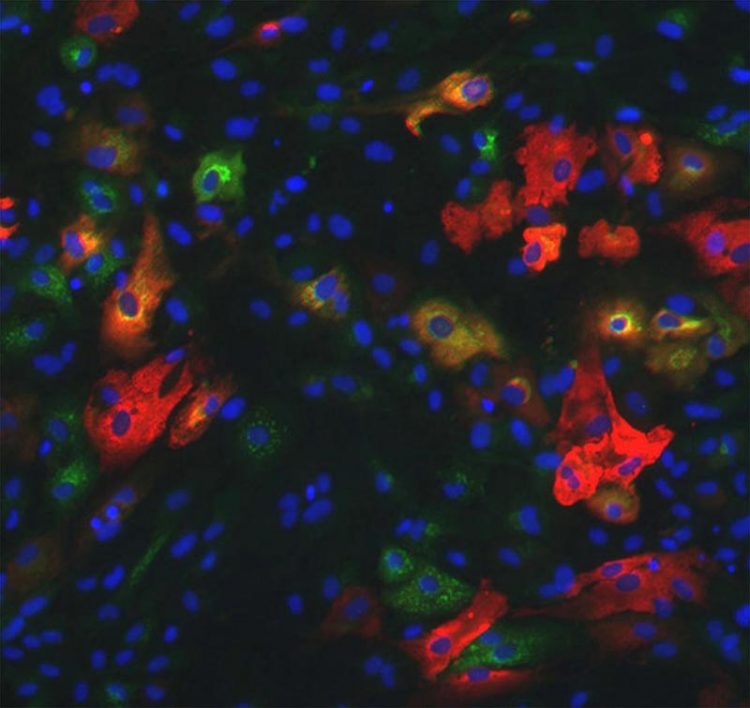Penn study on super-silenced DNA hints at new ways to reprogram cells

Enhanced reprogramming of skin cells (blue) to liver-like cells (red and green) by reducing expression of a repressive protein. Credit: The laboratory of Ken Zaret, PhD, Perelman School of Medicine, University of Pennsylvania
“In the past, most labs, including my own, used gene activators to turn on a new program to change the identity in a given cell,” said senior author Ken Zaret, PhD, director of the Penn Institute for Regenerative Medicine and a professor of Cell and Developmental Biology. “Our study shows that in some cases we will need to disassemble a cell's gene repression machinery to activate important genes to reprogram a cell's identity.”
The team attempted to reprogram skin cells to make new liver cells. Conversions of one cell type to another usually have low efficiencies, and this study identifies one reason why. The long term goal of this preclinical research is to be able to replenish diseased liver tissue with healthy tissue derived from a different tissue, such as skin cells, from the same individual in a process called direct-cell reprogramming
The Zaret lab untangled an extreme form of gene silencing, opening up regions of tightly wound DNA that is difficult for activators to reach to turn on certain genes. They found the regions by characterizing an increase in chemical cross-linking due to DNA being more compacted in the scaffolding of repressed regions of chromosomes
“Think of a piece of fishing line that has been used for a while, with several knots along its length,” Zaret said. “The knotted areas are more easily cross-linked regions, reflecting them being super-silenced areas of DNA.”
For the body to maintain its 200-plus different cell types, cells must activate genes specific to their type while simultaneously repressing genes of alternative types. Most genes in silenced DNA regions (not available to be “read” and made into a protein) are typically functions not used by the current cell type. Zaret likens it to insurance so cells don't mix up their identity, which could induce problems such as uncontrolled, cancerous cell replications, or so that brain or liver genes are kept from being expressed in skin cells, for example.
The team characterized the proteins that help make the regions “knotted” and found they were more complex than expected. “We found more types of different proteins than we thought we would,” Zaret said. To do this, they turned on the activity of once-silenced genes in human skin cells grown in culture to see if the knotted domain would open more easily when each was eliminated. Of the 50 proteins tested, some are also mutated in such neurodegenerative disorders as Lou Gehrig's disease.
“While most reprogramming genes are not in these super silent regions of DNA, very important genes are; so this gives us a new way to think about reprogramming,” Zaret said. The ultimate goal of their study is to find more efficient ways to reprogram one cell type into another by awakening silenced genes plus adding activators.
###
This study was funded in part by the National Institutes of Health (P01 GM099134, F31 DK107183, R01 110174, R01 AI118891)
The first authors are Justin S. Becker, Ryan L. McCarthy, and Kelsey Kaeding, all from the Zaret lab.
Penn Medicine is one of the world's leading academic medical centers, dedicated to the related missions of medical education, biomedical research, and excellence in patient care. Penn Medicine consists of the Raymond and Ruth Perelman School of Medicine at the University of Pennsylvania (founded in 1765 as the nation's first medical school) and the University of Pennsylvania Health System, which together form a $6.7 billion enterprise.
The Perelman School of Medicine has been ranked among the top five medical schools in the United States for the past 20 years, according to U.S. News & World Report's survey of research-oriented medical schools. The School is consistently among the nation's top recipients of funding from the National Institutes of Health, with $392 million awarded in the 2016 fiscal year.
The University of Pennsylvania Health System's patient care facilities include: The Hospital of the University of Pennsylvania and Penn Presbyterian Medical Center — which are recognized as one of the nation's top “Honor Roll” hospitals by U.S. News & World Report — Chester County Hospital; Lancaster General Health; Penn Wissahickon Hospice; and Pennsylvania Hospital — the nation's first hospital, founded in 1751. Additional affiliated inpatient care facilities and services throughout the Philadelphia region include Good Shepherd Penn Partners, a partnership between Good Shepherd Rehabilitation Network and Penn Medicine.
Penn Medicine is committed to improving lives and health through a variety of community-based programs and activities. In fiscal year 2016, Penn Medicine provided $393 million to benefit our community.
Media Contact
All latest news from the category: Life Sciences and Chemistry
Articles and reports from the Life Sciences and chemistry area deal with applied and basic research into modern biology, chemistry and human medicine.
Valuable information can be found on a range of life sciences fields including bacteriology, biochemistry, bionics, bioinformatics, biophysics, biotechnology, genetics, geobotany, human biology, marine biology, microbiology, molecular biology, cellular biology, zoology, bioinorganic chemistry, microchemistry and environmental chemistry.
Newest articles

NASA: Mystery of life’s handedness deepens
The mystery of why life uses molecules with specific orientations has deepened with a NASA-funded discovery that RNA — a key molecule thought to have potentially held the instructions for…

What are the effects of historic lithium mining on water quality?
Study reveals low levels of common contaminants but high levels of other elements in waters associated with an abandoned lithium mine. Lithium ore and mining waste from a historic lithium…

Quantum-inspired design boosts efficiency of heat-to-electricity conversion
Rice engineers take unconventional route to improving thermophotovoltaic systems. Researchers at Rice University have found a new way to improve a key element of thermophotovoltaic (TPV) systems, which convert heat…



